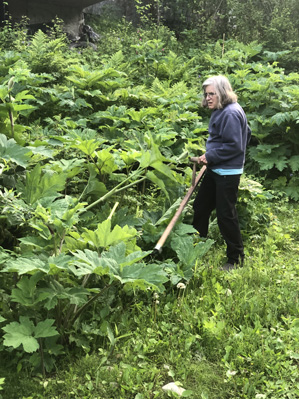
June 25, 2023: Cow Parsnip
On this bright and beautiful day -- I spent the morning cutting down, then raking cow up parsnip – it is in abundance everywhere, but I chose to scythe the area to the right of the driveway, coming onto our property. I don’t know why I did this because there are so many other things that need doing. Pete was more practical – he turned the fall compost and weeded the strawberries. Maybe it’s that I like more movement-related yard/garden activities. Every year I cut down the cow parsnip. I do believe that repeated cuttings are reducing the amount – and the ferns are growing in number. It’s nasty, noxious stuff. I wore gloves while I worked. |
|
This evening I gathered it up, using the hedge row rake and the shovel. I put it in the cart and emptied it in a pile. My timing was good – it had not yet gone to seed in this particular area. Cow parsnip (Heracleum maximum) “is native to North America and grows in a variety of habitats including woodlands, forest openings, grasslands, stream, and river edges and along roadsides. It’s sap contains a phototoxin that reacts with ultraviolet light to cause skin irritation ranging from a mild rash to severe blistering.” This biennial plant flowers in its second year and has a flower stem that may grow more than 6 feet tall. The flower head, made up of numerous small white flowers, is close to a foot across. The plant's leaves can be almost 2 feet wide. It has a hollow stem, and deep roots.” Pete says that it has a rhizome. “Cow parsnip is found near water and in rich, moist soil, often along stream banks, meadows, and wet ditches. It also grows well in partial shade along roads and in floodplain forests. It blooms from late May to late June. It’s an invasive species and cold hardy. It is used as a food and medicinal plant.”0 “Cow parsnip sap contains furanocoumarins, phototoxic chemicals that are activated by the sun’s ultraviolet rays. If the sap gets on skin and is exposed to sunlight, it can cause a blistering itchy rash. It can also cause nasty burns that take weeks or months to heal and can leave scars. If the plant touches your skin, you’re to wash the area with soap and water and protect this area from sunlight for 48 hours.” The stuff is near impossible to get rid of. Some recommend hand pulling it. This would be impossible here, given that there is so much of it. Others recommend using a herbicide, such as Round up. No, no, and no to this idea. Some also recommend using D Amine Weed Killer. I don’t know what the worms would think of this, so I’m not going to chance it. Well, the horses now have more yard space and perhaps the grass will grow limitedly this year. One year I tried to improve the soil life in that area by layering compost and cardboard and sprinkling grass seeds on top. Nothing happened. My one permaculture foray was a bust. |
|
